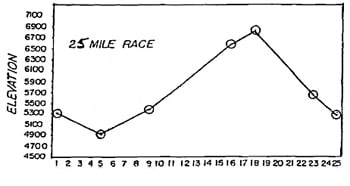Did you know there are races where people race against horses? One such race takes place in Arizona. It is called The Man Against Horse Race.
On race day, three races take place simultaneously. There is a 12 mile race, a 25 mile race and a 50 mile race.
Vocabulary – simultaneously: Happening at the same time, existing at the same time, or done at the same time.
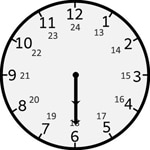
2. What is this kind of clock called?
The 25-mile run and trail ride starts at 7:30 in the morning and the 12-mile run and trail ride starts at 7:45 in the morning.
3. How much later is the 12-mile start time than the 50-mile start time?
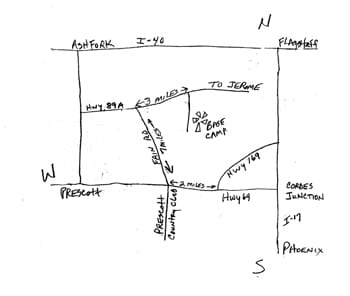
Map to base camp and start of race.
It is one thing to know what time the race starts. It is another to know where the race starts. Race organizers provide a map showing runners and riders how to get to base camp (the starting location).
4. On the map, what do the letters N, W and S stand for?
5. From the junction of Hwy 169 and Hwy 69, how far is it to base camp?
In 2008, Kim Abbott won the 50-mile race on her horse Sea Spot Run. That year, Paul Bonnett from Scottsdale, Arizona, was close behind. He crossed the finish line in 7 hours, 57 minutes, just 20 minutes behind Abbott.
6. What was Abbott and Sea Spot Run’s finishing time?
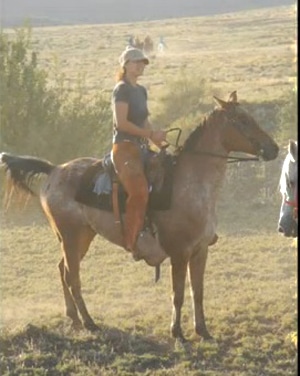
Abbott will be racing again this year. She isn’t worried about the trail conditions. She generally dismounts, and in what endurance riders call “tailing,” hangs on to her horse’s tail and walks behind him up the backside of Mingus Mountain, where the trail is steepest and rockiest.
Plenty of information is provided for the participants; registration information, a map of the course and – a map showing changes in elevation.
7. What does the horizontal axis indicate on the graph to the right?
8. What does the vertical axis indicate on the graph?
9. At what mile is the course at its lowest elevation?
10. At what mile is the course elevation the highest?
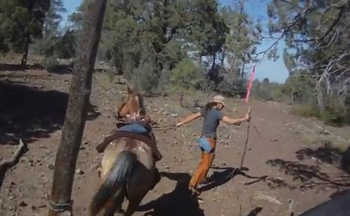
Sometimes riders have to dismount in order to open and close a gate.
Runners also have an advantage as horses must stop and pass two timed rest/veterinary checks before they can continue along the trail. Runners can push themselves as hard as they dare.
Whether on horseback or running, the race is grueling. Weather can vary from freezing to boiling, and include hail, rain and wind. Both runners and riders must be cautious to avoid injury while moving fast enough to win.
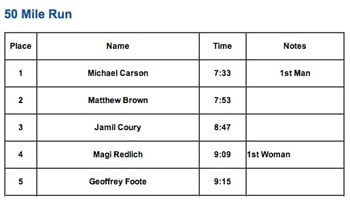
11. How much faster did the first place man run than the first place woman?
The same year, the first place horse and rider team finished with a time of 6 hours and 45 minutes.
12. How much faster were the horse and rider team than the first place runner?
Along the way, race director Barrett said, the Yavapai County Jeep Posse members are the race’s angels. They assist runners and riders with food, water, first aid, and encouragement, and at the end of the race, make sure all racers are safely off the trail.
It is a bit of a bumpy ride, but if you want to see what it is like riding in the Man Against Horse race, check out this video of the 2016 race.
Click here is you would like to see more pictures of the race.
1. The 50-mile run and trail ride starts at the time shown on the clock. What time does the race start? Be sure to include a.m. or p.m. in your answer.
Answer: 6:30 a.m.
2. What is this kind of clock called?
Answer: 24-hour clock
3. How much later is the 12-mile start time than the 50-mile start time?
Answer: 1 hour and 15 minutes later.
4. On the map, what do the letters N, W and S stand for?
Answer: North, West and South.
5. From the junction of Hwy 169 and Hwy 69, how far is it to base camp?
Answer: 2 miles + 7 miles + 3 miles = 12 miles. It is 12 miles from the junction of Hwy 169 and Hwy 69 to base camp.
6. What was Abbott and Sea Spot Run’s finishing time?
Answer: 7 hrs and 57 minutes – 20 minutes = 7 hrs and 37 minutes. Abbott and Sea Spot Run’s finishing time was 7 hrs and 37 minutes.
7. What does the horizontal axis indicate on the graph to the right?
Answer: Miles in the race.
8. What does the vertical axis indicate on the graph?
Answer: Elevation of the trail.
9. At what mile is the course at its lowest elevation?
Answer: At mile 5.
10. At what mile is the course elevation the highest?
Answer: At mile 18.
11. How much faster did the first place man run than the first place woman?
Answer: 9 hours and 9 minutes – 7 hours 33 minutes = 1 hour and 36 minutes. The first place man finished 1 hour and 36 minutes faster than the first place woman.
12. How much faster were the horse and rider team than the first place runner?
Answer: 7 hours 33 minutes – 6 hours and 45 minutes = 48 minutes. The first place horse and rider team finished 48 minutes ahead of the first place runner.
Photos:
YouTube



